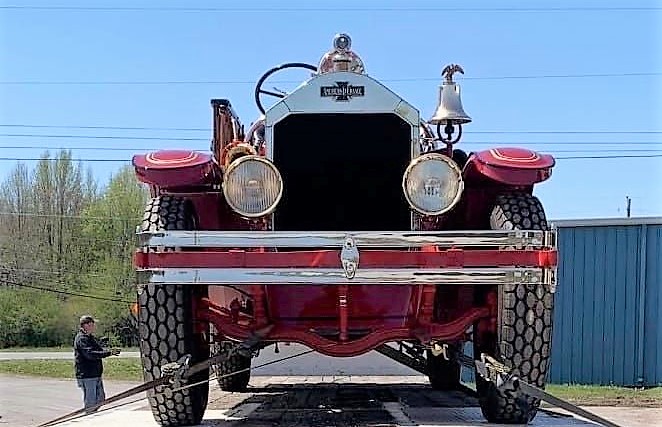
FOUND IN OREGON
A 95-year-old fire engine was found almost 2,300 miles away, and returned to its original home in Paris, Tennessee, 55 years after it left.
Webb, who also is president of the Historical Society, discovered the apparatus at the Tualatine Valley Fire & Rescue near Portland, Oregon. After learning of the pumper’s whereabouts, Webb wrote to the fire department’s chief and CEO, Michael Duyck, in 2018 to inquire if it was possible for the engine to return to Paris. Webb received a favorable reply, and TVF&R supported transferring ownership of the engine back to its original hometown. “We are grateful to TVF&R for donating the fire engine, and our community was excited to learn that it still existed and would be brought back home,” said Webb.
Webb spearheaded the spearhead the project to transport the apparatus back to Paris and raise funds for its repair and restoration. He traveled to Wilsonville, Oregon, to sign off on paperwork with TVF&R and witness the loading of the fire engine on January 11, 2019.
Webb spoke extensively with Ken Lauderback, a TVF&R volunteer, and took several photographs and videos noting mechanical, operational, and cosmetic issues with the vehicle. The apparatus was equipped with a bell, siren, ladder, hard suction hoses, nozzles, etc. Some of its original paint, gold leaf, pin striping, scrollwork, and lettering spelling out PARIS FIRE DEPARTMENT were still visible.
For Lauderback, saying goodbye to an old friend was bittersweet. “I am a firm believer that if a community wants to preserve their own history, they should be given the opportunity to do that.”
“The apparatus was in our fleet of antique fire engines at our Wilsonville, Oregon, station. I was on point when David Webb came out to pick her up and bring her home to Paris, Tennessee, where she should be. She’s a beautiful rig and I’m pretty excited to see her back to her former glory! It’s pretty exciting to see history on wheels,” said TVF&R Captain Mychal Wickam.
BRINGING IT HOME
Webb enlisted the help of Walter Flowers Trucking of Springville, Tennessee, which brought the vehicle from Wilsonville to Paris free of charge. Joe Jackson, who loaded and transported “Engine 1” for its 2,274-mile journey, noticed many turned their heads to admire the apparatus while it was on interstate highways. One person followed the rig for many miles until the trailer stopped so he could get a closer look; another made an offer to buy the engine on the spot.
The fire engine arrived at the Paris Fire Department’s Station 2 on January 18th, and it was met by several citizens and current and retired firefighters. Also on hand was local artist Dan Knowles, who took pictures of the vehicle and later incorporated the apparatus into a downtown Paris mural in the west alley that included Webb and Fire Chief Michael Williams. The apparatus replaced Knowles’ original idea to paint a circus vehicle. Also present was J.R. Hayes’ grandson, Matt Hayes, who brought along his sons, Lee and Wade. Later, the J.R. Hayes Construction Company donated $426.51—the same price J.R. Hayes paid for the vehicle in 1964.
RESTORATION
David “Dave” Miles, owner of Pipestone Restorations in Waverly, contacted Webb with an offer to conduct a frame-up restoration of the fire engine with in-kind labor if the historical society provided funds for the materials. The business had restored Waverly’s 1942 Dodge pumper that was damaged in the city’s historic 1978 explosion that killed 16 people following the derailment of a railroad tanker that carried liquid propane.
Father and son restoration specialists Paul A. “Rusty” and Paul V. “Dusty” Puckett expertly began the 1927 fire engine project in 2020, and their work exceeded expectations. Along with a gold leaf artist, the men restored the fire engine as close to its original condition as practical. Hundreds of photographs were taken to document the restoration process and replicate the original details. Webb tracked down 1920s parts in antique shops, online stores, and on social media across the country.
Pipestone Restorations removed the original lead paint down to the bare metal which was then coated with a rust proofing material before priming and painting. The wooden artillery wheels are original, however dry rot was removed and filled in and covered with polyurethane instead of regularly applying linseed oil to preserve them as they did in the past.
According to Webb, “Our goal was to maintain the fire engine’s authenticity down to a restored original 1927 Tennessee license plate, however, we took some liberties for safety, including installing new wiring and other parts of the electrical system. The deteriorated gas tank, running boards, tailboard, and wooden storage boxes were replaced with replicas. A smaller auxiliary gas tank avoids having gasoline in the tank for an extended period that could damage the original motor. We added a cotton American flag with 48 stars—the number of stars in 1927 when the fire engine was new.”
“This is truly a fantastic restoration, and not just because we did it. Paris and Henry County should be very proud of the fire engine,” said Miles. “I am amazed at Rusty and Dusty Puckett’s workmanship; they are truly craftsmen. There were parts not currently available for a 1927 fire engine, so the guys fabricated what we needed. The people in the West Tennessee community have a true masterpiece now the vehicle is restored.”
“I just think we’re fortunate to get our hands on a piece of Tennessee history. It has been an interesting and challenging restoration for sure, but one my son and I will remember for the rest of our lives,” said Rusty Puckett.
“What Paris and Henry County has here is a work of art from the 1920s art deco period when design and details, as well as function, really mattered,” said Dusty Pucket.
The Historical Society contracted artist Stephen Filarsky of Franklinton, North Carolina, to replicate the gold leaf, pin striping, and scrollwork. “The gold leaf and other details are absolutely amazing,” said Miles.
“We have had over two years of time with the antique fire engine, but it really came to life when Steve worked his magic on it. It’s been a pleasure having him with us at Pipestone to perform his artistry. His artwork will carry on for everyone to view in years to come,” said Rusty Puckett. “What more can a person ask as a legacy, but to leave a mark on history?”
“The historical society could not have come this far with the project without the guys from Pipestone Restorations. Their repair and restoration of this classic American fire engine is nothing short of world class,” said Webb.
COMMUNITY SUPPORT
“We are very thankful for the financial and in-kind support from the Paris-Henry County community,” said Webb. The City of Paris, County of Henry, Paris Board of Public Utilities Trust, Henry County Helping Hand, Holley Credit Union, and many other businesses, organizations, and citizens gave financial support. Tennessee Tractor donated an alternator; Bud Winsett fashioned reproduction leather straps; Wayne Webb acquired hose and a copper fire extinguisher; Arnold’s Fabricating & Machine of Camden created a duplicate brass tailboard corner and transported the fire engine from the restorers back to Paris.
“Our goals are to honor the legacy of firefighting, as well as the master craftsmen who built this beautiful piece of machinery that is both very practical and beautiful. We want to see the fire engine in parades, fairs, car shows, and other public events to represent and promote our great community. It is now our community’s charge to preserve this important piece of our local history by obtaining or building a facility to showcase it and provide for its continual maintenance, fuel, and insurance for present and future generations to enjoy,” said Webb. “We hope that after our citizens look at this beauty, they will support having a place where locals and visitors can come and view the fire engine in glassed in facility at any time.”
According to Webb, the restoration project is ongoing. We still need a few parts to complete the project, including an oil can, nozzle tip, and add a second nozzle. We also would like to add the means to transport caskets for firefighter funerals.
Donations toward the fire engine project can be mailed to the Henry County Historical Society, 2316 Hamlin Dr., Paris, TN 38242.
HISTORY
In 1928, a three-man committee, that included Mayor Ed M. Culley, was formed to consider the purchase of a new pumper water tanker for the City of Paris, Tennessee. In February, the city council signed the contract with the American LaFrance-Fire Engine Co. of Elmira, New York. For $11,500 and the trade-in of its 1914 American-La France Type 110, the city purchased the new fire engine as well as a 1913 ALF pumper from Hickman, Kentucky.
The 1927 American-La France apparatus was shipped by rail to Paris on March 4, 1928. The vehicle was described as “modern in every respect” with its six-cylinder 130 horsepower T-head engine, dual chain rear axle drive, wooden artillery wheels, and a 750 gallon per minute rotary gear pump with four hose connections. The City of Paris became “one of the best equipped of the smaller cities in the state insofar as firefighting equipment is concerned”
A crowd of Parisians greeted the 7,637-lb. fire engine as it emerged from a special railroad freight car on April 3, 1928. “Engine 1” served the city for decades until it was taken out of service and stored in a shed behind the city hall.
PAST OWNERSHIP
The apparatus was sold at auction in March 1964, to J.R. Hayes for $426.51. Hayes, owner of a local road construction company, drove the rig in “World’s Biggest Fish Fry” parades in Paris and let his grandchildren play and ride on it. He sold the engine to Cooter Brown, who also drove it for special events, such as the Paris-Henry County Sesquicentennial Parade, celebrating the community’s 150th birthday in 1973.
The fire engine was purchased by Larry Robison of Bruceton, who then sold it to Myron and Betty Lou Curtis of Portland, Oregon, in 1980. Myron Curtis owned a trailer manufacturing company, and he and his wife flew into a Louisville, Kentucky, airport and obtained a trailer to transport the apparatus. While it was being loaded, the trailer collapsed under the vehicle’s weight. Curtis had the trailer reinforced, and he drove the engine through a sandstorm and a snowstorm with the trailer fishtailing on the way to Portland.
After Curtis’ death, his family donated the apparatus to Tualatin Valley Fire & Rescue in Tigard, Oregon, in 2016. It became part of the fire department’s collection of antique firefighting equipment and was housed in its Wilsonville station. Auxiliary volunteers participated in community events, such as auto shows and parades. One of the volunteer members, Ken Lauderback, maintained and drove the vehicle ever since it was first brought to Oregon in 1980, and he was a walking encyclopedia of antique fire engine knowledge.
Photo: The 1927 American LaFrance, back home again. Photo by David Webb.




